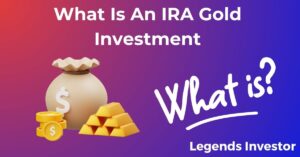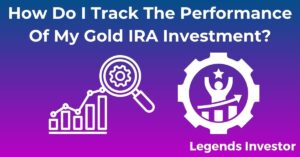Introduction to Diversifying Your IRA Investments
Understanding Individual Retirement Accounts (IRAs)
Individual Retirement Accounts (IRAs) are essential tools for retirement planning, offering tax advantages to help individuals save for their future. IRAs come in different types, including Traditional IRAs, Roth IRAs, SEP IRAs, and SIMPLE IRAs, each with its own rules regarding contributions, tax benefits, and withdrawals. The primary purpose of an IRA is to grow your savings through various investments over time, preparing you for a financially secure retirement.
Why Gold Has Been a Traditional Investment Choice for IRAs
Gold has long been considered a stable and reliable investment, particularly during times of economic uncertainty. It acts as a hedge against inflation and currency fluctuations, maintaining its value over the long term. Including gold in an IRA can provide a safeguard against market volatility, offering a sense of security and diversification in your retirement portfolio.
Importance of Diversification in Retirement Planning
Diversification is a key strategy in retirement planning. It involves spreading your investments across various asset classes to reduce risk and enhance potential returns. By diversifying your IRA investments, you can protect your portfolio from significant losses and take advantage of growth opportunities in different sectors. A well-diversified IRA can help achieve a balanced approach to retirement savings, tailored to your risk tolerance and financial goals.
Brief Overview of Alternatives to Gold for an IRA Portfolio
While gold is a popular choice for IRA investments, there are several other alternatives that can diversify and strengthen your portfolio. These include other precious metals like silver, platinum, and palladium, Real Estate Investment Trusts (REITs), stocks, bonds, Exchange-Traded Funds (ETFs), mutual funds, high-yield savings accounts, Certificates of Deposit (CDs), peer-to-peer lending, startup investments, and Sustainable and Responsible Investing (SRI) options.
Exploring the World of Precious Metals Beyond Gold
Benefits of Including Silver, Platinum, and Palladium in Your IRA
Adding silver, platinum, and palladium to your IRA can provide additional layers of diversification and potential growth. Each metal has unique industrial applications and market dynamics:
- Silver: Known for its use in electronics, solar panels, and medical devices, silver can benefit from technological advancements and industrial demand.
- Platinum: Used in automotive catalytic converters, platinum is tied to the automotive industry’s health and technological innovations in green energy.
- Palladium: Like platinum, palladium is crucial in catalytic converters, and its market is influenced by regulatory changes in automotive emissions.
Comparison of Performance and Market Stability with Gold
While gold is often seen as a safe haven, silver, platinum, and palladium offer different risk-reward profiles. Historically, gold has shown relative stability, whereas silver tends to have more volatility and potential for higher returns. Platinum and palladium are influenced by industrial demand and supply constraints, making them more susceptible to market fluctuations but also offering significant growth opportunities.
How to Include Other Precious Metals in Your IRA
To include precious metals in your IRA, you need to open a self-directed IRA (SDIRA) with a custodian that allows investments in these assets. Ensure the metals meet the IRS’s purity standards:
- Gold: 99.5% purity
- Silver: 99.9% purity
- Platinum and Palladium: 99.95% purity
Work with a reputable dealer and your custodian to purchase and store the metals in an approved depository.
Real Estate Investment Trusts (REITs): Property in Your Portfolio
What REITs Are and How They Work
REITs are companies that own, operate, or finance income-generating real estate across various sectors, such as residential, commercial, and industrial properties. They pool investor funds to purchase and manage properties, distributing a significant portion of the income as dividends. REITs provide a way to invest in real estate without directly owning property.
Advantages of Including REITs in an IRA
REITs offer several benefits for IRA investors:
- Income Generation: Regular dividend payments provide a steady income stream.
- Diversification: Exposure to real estate markets can balance other asset classes.
- Liquidity: Publicly traded REITs are easier to buy and sell compared to physical real estate.
Understanding the Risks Involved with REITs
Investing in REITs carries risks, including market volatility, interest rate fluctuations, and sector-specific challenges. It’s essential to research and choose REITs with strong track records and diversified property holdings to mitigate these risks.
Stocks and Bonds: Traditional But Effective
Diversity Within the Stock Market: Sectors and Company Size
Investing in stocks allows for broad diversification within different market sectors (e.g., technology, healthcare, finance) and company sizes (large-cap, mid-cap, small-cap). This approach can capture growth opportunities while spreading risk across various industries and market capitalizations.
Incorporating Government and Corporate Bonds
Bonds provide a fixed income component to your IRA, offering stability and predictable returns. Government bonds (e.g., U.S. Treasuries) are considered low-risk, while corporate bonds offer higher yields with increased risk. Including both types can balance safety and return potential.
Strategies for Balancing Stocks and Bonds in Your IRA
An effective strategy involves balancing stocks and bonds based on your risk tolerance and time horizon. Younger investors might favor a higher stock allocation for growth, while those nearing retirement may prioritize bonds for stability. Regularly rebalancing your portfolio ensures it stays aligned with your goals.
The Rise of Exchange-Traded Funds (ETFs) in Retirement Planning
What Are ETFs and How Do They Differ from Mutual Funds?
ETFs are investment funds traded on stock exchanges, holding a diversified portfolio of assets like stocks, bonds, or commodities. Unlike mutual funds, ETFs are bought and sold throughout the trading day at market prices. They typically have lower fees and offer more flexibility in trading.
Pros and Cons of Including ETFs in Your IRA
Pros:
- Diversification: Broad exposure to various asset classes and sectors.
- Cost-Effectiveness: Generally lower expense ratios compared to mutual funds.
- Flexibility: Easy to trade and manage within an IRA.
Cons:
- Trading Costs: Frequent trading can incur additional fees.
- Market Risk: Subject to market fluctuations and volatility.
Sector-Specific ETFs vs. Broad-Market ETFs
Sector-specific ETFs focus on particular industries (e.g., technology, healthcare), allowing targeted exposure. Broad-market ETFs offer diversification across the entire market, reducing sector-specific risks. A combination of both can provide balanced growth and stability.
Leveraging Mutual Funds for Diversification
The Role of Mutual Funds in an Investment Portfolio
Mutual funds pool investor money to purchase a diversified portfolio of assets managed by professionals. They offer diversification, professional management, and convenience, making them a popular choice for IRA investors.
Active vs. Passive Managed Funds: What’s Better for Your IRA?
Active Funds: Managed by professionals aiming to outperform the market. Higher potential returns but come with higher fees and risk. Passive Funds: Track a specific index (e.g., S&P 500), aiming to replicate its performance. Lower fees and risk, but generally offer market-average returns. The choice depends on your investment goals, risk tolerance, and preference for cost vs. potential performance.
Understanding the Fee Structures in Mutual Funds
Mutual funds have various fees, including:
- Expense Ratios: Annual fees for fund management and operations.
- Load Fees: Sales charges for buying (front-end load) or selling (back-end load) shares.
- Management Fees: Fees for the professional management of the fund.
Understanding these fees is crucial for evaluating the cost-effectiveness of your mutual fund investments.
Considering High-Yield Savings and Certificates of Deposit
The Safety Net of FDIC-Insured Savings Strategies
High-yield savings accounts and Certificates of Deposit (CDs) offer FDIC insurance, protecting your principal up to $250,000 per depositor, per bank. They provide a safe, low-risk way to grow your retirement savings, albeit with lower returns compared to market-based investments.
Interest Rate Environments and the Attractiveness of CDs
CD rates are influenced by prevailing interest rates. In higher interest rate environments, CDs become more attractive due to their guaranteed returns. However, in low-rate environments, their appeal diminishes compared to potentially higher-yielding investments.
Laddering CDs for Liquidity and Interest Benefits
CD laddering involves spreading your investment across multiple CDs with varying maturities. This strategy provides regular access to funds and takes advantage of higher interest rates on longer-term CDs, balancing liquidity and return.
Innovative Investment Avenues: Peer-to-Peer Lending and Startups
The Growing Landscape of Peer-to-Peer (P2P) Lending
P2P lending platforms connect borrowers with individual investors, offering potentially higher returns than traditional savings accounts. By lending small amounts to multiple borrowers, you can diversify your risk while earning interest on your investments.
Venture into the World of Startup Investing
Investing in startups through equity crowdfunding or angel investing can yield significant returns if the ventures succeed. However, these investments come with high risk and illiquidity, requiring thorough research and due diligence.
Risk Assessment and Due Diligence for Non-Traditional IRA Investments
Non-traditional investments like P2P lending and startups require careful risk assessment and due diligence. Evaluate the platform’s reputation, borrower creditworthiness, and startup business models to mitigate potential losses.
Sustainable and Responsible Investing (SRI): Aligning Values with Investments
What Is SRI and Why Is It Gaining Popularity?
SRI involves investing in companies and funds that prioritize environmental, social, and governance (ESG) criteria. It allows investors to align their portfolios with their values, supporting sustainable and ethical business practices.
Identifying SRI Opportunities for Your IRA
Look for SRI funds or ETFs that focus on ESG criteria. Many financial institutions offer SRI options, making it easier to incorporate these investments into your IRA.
Measuring the Impact of SRI on Financial Returns and Society
SRI can deliver competitive financial returns while contributing to positive societal impacts. Research shows that companies with strong ESG practices often exhibit better long-term performance and risk management, making SRI a viable investment strategy.
Conclusion: Crafting a Personalized and Dynamic IRA Investment Strategy
Reviewing the Alternatives to Gold Within an IRA
Explore various investment options beyond gold, such as other precious metals, REITs, stocks, bonds, ETFs, mutual funds, high-yield savings, CDs, P2P lending, startups, and SRI. Diversifying across these assets can enhance your IRA’s growth potential and resilience.
Assessing Personal Risk Tolerance and Retirement Goals
Tailor your IRA investment strategy to your risk tolerance and retirement objectives. A well-balanced portfolio should reflect your comfort with risk and your long-term financial goals.
The Importance of Continuous Learning and Staying Updated on Investment Options
Stay informed about market trends and new investment opportunities. Continuous learning and adapting your strategy are crucial for maximizing your IRA’s potential and securing a comfortable retirement.
Consulting with a Financial Advisor to Build and Adjust Your Investment Plan
Work with a financial advisor to develop and periodically review your IRA investment plan. Professional guidance can help you navigate complex investment choices and ensure your strategy remains aligned with your retirement goals.



